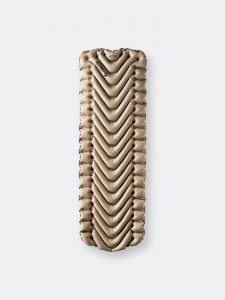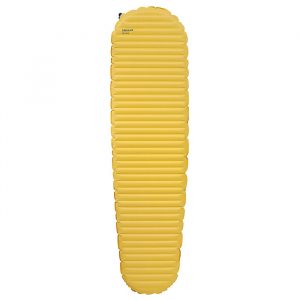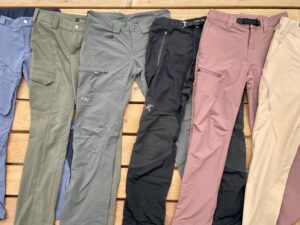If you are a climber, polar explorer, or anyone considering an expedition in subfreezing temperatures, you’ll need a suitable cold-weather sleeping pad. At a minimum, the right pad gives proper insulation for a good night’s sleep in cold weather. But today’s sleeping pads are advanced enough to have a whole lot more, including a high R-value, packability, durability, and comfort.
Cold-weather sleeping pads: Polar tested
A strong R-value (how well an object resists heat transfer) is an indication of a good cold weather pad. Summer sleeping pads range from an R-value of 1 – 3, while 3-Season sleeping pads range from 3 – 5. Then, 4-Season (the most extreme) have an R-value of 5 or higher.
Although warmth is our top consideration, we also consider weight and packability for our list of best performing sleeping pads below. Whichever pad you choose, make sure your entire sleep system, including the tent, sleeping bag, and clothing, is well-curated for cold-weather excursions.
Sea to Summit Comfort Plus XT Insulated Air, $240

Best For: Everything from winter expeditions to short backpacking and car camping trips
- Category: Air pad
- Weight: 1.2kg (2 lbs. 9.8 oz.)
- Thickness: 7.6cm (3 in)
- Insulation Type: Insulated Air
- R-value: 4.7
- Pros: Incredibly comfortable
- Cons: Heavy and bulky
- Sustainability Features: None
The Sea to Summit Comfort Plus XT synthetic insulated sleeping pad is a comfortable, 4-season sleeping pad that’s great when the weather gets chilly. Its 7.6cm (3 in) thick interconnected chambers support and conform to your body. We especially like that the Comfort Plus has two layers of XT Air-Sprung Cells providing adjustable support (the bottom can be firm for extra support and protection from rough terrain, while you can fine-tune the top to your personal preference). An advantage to this design is that it adds reassurance in case one layer gets punctured.
When comparing the Comfort Plus XT with the popular Comfort Plus, the Plus XT weighs a hefty 1.2kg (2 pounds 9.8 ounces), adding 340gm (12 ounces) to your pack over the Comfort Plus. However, we found that the rectangular shape of the Plus XT is suitable for all types of sleepers.
It’s also superior to the Comfort Plus in comfort and warmth, with an added half-inch of thickness and an increased R-value of 4.7 (versus 4.0). The weight of the XT may be a burden in your backpack, but on a long-distance manhauling trek, or anywhere that comfort is important, this is our first choice.
See the Sea to Summit Comfort Plus XT Insulated Air
Therm-a-Rest NeoAir Xtherm, $220

Best For: Very lightweight cold-weather option
- Category: Air pad
- Weight: 425gm (15 oz)
- Thickness: 6.3cm (2.5 in)
- Insulation Type: Insulated Air
- R-value: 6.9
- Pros: High R-value, lightweight, and highly compactable
- Cons: Not the most silent or comfortable sleeping pad
- Sustainability Features: None
Therm-a-Rest is known for crafting solid sleeping products with exceptional warmth, impressive weight, and remarkable packability. Unlike down or synthetic filler insulated pads, air pads like the NeoAir Xtherm don’t typically include a filler insulation. Instead, they use metallic thermal linings on their internal baffle surfaces to retain heat. In the case of the Xtherm, its stacked triangular air baffles, lined with a reflective coating, make this pad a strong powerhouse for warmth, providing excellent insulation with a captivating R-value of 6.9.
With that said, the NeoAir XTherm earns our best lightweight sleeping pad choice because it compresses down to about the size of a water bottle and weighs an exemplary 425gm (15 oz). Compare that to the 1.1kg of the Comfort Plus XT above. If you need to be equipped for rowdy excursions, then the XTherm provides a 70-denier bottom, creating a durable pad that can last for many adventures. If you need more variety in sizing, then the XTherm MAX offers a few additional options with comparable specs.
We would be remiss if we didn’t address the pad’s initial crinkle sound that may not be ideal for light sleepers. And with Therm-a-Rest’s standard 6.3cm thickness, it’s not the most comfortable sleeping pad compared to those with a more congenial 7.6cm (3 in) thickness. However, if you need serious warmth and a pad that’s incredibly lightweight and don’t mind a slight sacrifice in comfort, then the XTherm is our best lightweight sleeping pad choice. Besides, if you’re sleeping on snow, your floor is already soft. All you need is insulation.
See the Therm-a-Rest NeoAir Xtherm
Big Agnes Insulated Air Core Ultra, $200

Best For: Cold-weather campers and explorers on a budget
- Category: Air pad
- Weight: 623gm (1 lb 6 oz)
- Thickness: 8.25cm (3.25 in)
- Insulation Type: Synthetic
- R-value: 4.5
- Pros: Reasonable price range; even lower price for shorter lengths
- Cons: Vertical baffles make it relatively squeaky
- Sustainability Features: 3M repair patches included
If you are not camping in frigid temperatures and don’t plan on many excursions, you may not want to spend upwards of $150 on a sleeping pad. Some sleeping bags cost that much. We found the Big Agnes Insulated Air Core Ultra to be an excellent value for a reasonable price. But the price isn’t its only appealing factor; you will find yourself on ample 8.25cm of thickness on tall lengthwise chambers that keep you on the pad. Its double ripstop fabric increases strength by 25 percent, making this pad durable over harsh terrain.
For those looking for a 3-season sleeping pad, then the Air Core Ultra is a superb introductory pad with an R-value of 4.5. Differentiating this sleeping pad from many Therm-a-Rest pads, the Air Core Ultra is bulkier and heavier at 624gm (1 lb 6 oz). But compared to Sea to Summit’s Comfort line in the one-kilo range, this pad marks an even balance.
While not the most impressive sleeping pad on the market, we like the Air Core Ultra because it provides air construction with synthetic insulation for decent warmth and cushion without extreme excess weight while well within an acceptable price range.
See the Big Agnes Insulated Air Core Ultra
Nemo Switchback Ultralight Sleeping Pad, $40

Best For: A must-have supplemental foam pad
- Category: Closed-cell foam
- Weight: 298gm (10.5 oz)
- Thickness: 2.3cm (0.9 in)
- Insulation Type: Foam
- R-value: 2.0
- Pros: Versatile sleeping pad; affordable, adds warmth and preserves air pads
- Cons: Should not be used alone in cold conditions
- Sustainability Features: None
The Nemo’s Switchback Ultralight sleeping pad should belong in every adventurist’s collection. This 2.3cm closed-cell foam sleeping pad’s metalized thermal reflective film is designed to help keep you warm by reflecting heat up toward your body. Containing an R-value of just 2.0, we don’t recommend individual use in cold weather. But, since R-values are additive, it will increase warmth when paired with an additional sleeping pad.
We found Nemo’s Ultralight to be an upgrade in weight, compactness, and comfort compared to Therm-a-Rest’s Z Lite SOL. Its hexagonal nesting pattern creates taller nodes for uncompressed insulation and efficient packability. The Ultralight has premium dual-density Axiotomic foam with a supple layer for comfort and a resilient layer for support.
At $40, the Ultralight is affordable, durable, and an excellent all-around sleeping pad. It can be paired with a sleeping pad to add warmth (R-values can be layered) and help keep your expensive inflatable air pad intact. Bonus: it can be used as a sitting pad on snow or a windbreak for cooking. The Ultralight’s versatility makes this pad a must-have.
See the Nemo Switchback Ultralight Sleeping Pad
Sea to Summit Ether Light XT Extreme, $200

Best For: Most comfortable cold-weather pad for side sleepers
- Category: Air pad
- Weight: 720gm (1 lb. 9.6 oz)
- Thickness: 10cm (4 in)
- Insulation Type: Synthetic
- R-value: 6.2
- Pros: Incredible comfort for all sleeping positions, especially side sleepers
- Cons: Heavier than others
- Sustainability Features: None
The Ether Light XT Extreme inflatable sleeping pad combines synthetic insulation with dual-density layers that reflect heat and prevent heat loss, resulting in a remarkable 6.2 R-value. With a height of 10cm (4 in), this thick pad amplifies comfort, especially for side sleepers, although, understandably, it adds to the weight and overall bulkiness. Most sleeping pads that venture beyond the 7.5cm (3 in) territory risk losing stability, but it’s Air Sprung Cell construction appears to mitigate this problem by being extra thick.
We consider the XT Extreme to be heavy at 720gm. In comparison, the Therm-a-Rest XTherm came in at an attractive 425gm (15 oz) with a higher R-value than XT Extreme’s 6.2. And for durability, the XT Extreme is slightly less durable with a 40-denier bottom than that of XTherm’s 70-denier.
Aside from the weight and thinner material, the XT Extreme offers considerable warmth and is terrific for side sleepers and light sleepers alike with added cushioning and crinkle-free top fabric. Considering these highlights, we classified the XT Extreme as one of the best in comfort for anyone who sleeps on their sides.
See the Sea to Summit Ether Light XT Extreme
Klymit Insulated Static V Luxe SL, $140

Best For: Sound-sensitive sleepers
- Category: Air pad
- Weight: 879gm (1 lb 15 oz)
- Thickness: 8.9cm (3.5 in)
- Insulation Type: Synthetic
- R-value: 6.5
- Pros: Dimensions are larger than most standard sizes
- Cons: Heavy; weighing close to two pounds
- Sustainability Features: None
The Klymit Insulated Statis V Luxe SL sleeping pad has a V-chamber design, its uniquely crafted lofted air pockets form to the body while providing almost 9 cm of ample space between you and the ground. Over 7.5cm (3 in), we like that the V Luxe SL has built-in, inflated side rails to keep you on your pad and off the frozen ground while keeping you warm with a spectacular 6.5 R-value. This luxury design sleeping pad provides soft and quiet material that provides an undisturbed, comfortable sleep.
Dimensions of the V Luxe SL measure at 198cm x 69cm (78” x 27”), making it roomier than most standard sleeping pads, albeit slimmer, yet warmer and lighter, than their Static V Luxe. But the V Luxe SL comes with a setback, weighing almost 900gm. That aside, we are surprised at its remarkable warmth, restrained price, and silent fabric, a worthy contestant against the NeoAir XTherm.
Admittedly, with the excess weight, it’s not our most ideal sleeping pad, but for the comfort and high R-value, the Klymit Insulated Static V Luxe SL is worth considering for those on cold excursions that don’t involve long distances.
See the Klymit Insulated Statis V Luxe SL
Therm-a-Rest Women’s NeoAir XLite Sleeping Pad, $180

Best For: Top-notch women’s specific sleeping pad
- Category: Air pad
- Weight: 340gm (12 oz)
- Thickness: 6.3cm (2.5 in)
- Insulation Type: Insulated Air
- R-value: 5.4
- Pros: Reasonable price
- Cons: Doesn’t come in any other size
- Sustainability Features: None
It’s not surprising that Therm-a-Rest sleeping pads keeping making it on our list, but what we did find surprising was discovering the Women’s NeoAir XLite sleeping pad. We chose the Women’s XLite (a stand-alone model, not a size) not only because it weighs a tidy 340gm but because it offers four-season, functional warmth with an R-value of 5.4.
There are a few things to mention. First, its limited sizing. The Women’s XLite sleeping pad is labeled for women, but many climbers can benefit from a warm and lightweight pad if they can fit on the 50cm x 167cm (20” x 66”) mummy-style sleeping pad. This pad has a moderately low 30-denier count and is accompanied by that pesky crinkle sound and only has a 6.3cm thickness, so we don’t consider this pad to be the most comfortable nor the highest in durability. But those compromises are what makes this Women’s XLite so lightweight.
If you are 5’ 6” and under and still want a four-season sleeping pad that’s exceptionally light without paying over $200, then we strongly suggest the Women’s XLite (although, not to confuse it with their other, less warmer, version “NeoAir XLite” sans “Women” in the title).
See the Therm-a-Rest Women’s NeoAir XLite Sleeping Pad
Nemo Tensor Alpine Ultralight Mountaineering Pad, $230

Best For: Ultralight sleeping pad option
- Category: Air pad
- Weight: 567gm (1 lb 4 oz)
- Thickness: 7.6cm (3 in)
- Insulation Type: Insulated Air
- R-value: 4.8
- Pros: Great packability and weight without sacrificing comfort
- Cons: Less durable and more expensive for a 3-season pad
- Sustainability Features: None
When it comes to Nemo’s insulated packable sleeping pads, the Tensor Alpine Ultralight Mountaineering Pad is the warmest in their product line, coming in at a 4.8 R-value, surpassing the Tensor Ultralight, Flyer, and Quasar pads. The Tensor Alpine’s warmth is mainly attributed to its three layers of suspended metalized film, facilitating an effective and efficient method in retaining your body heat.
While this pad states use for “extreme cold,” its three-season R-value warrants use in more moderate temperatures or it can be paired with a closed-cell foam pad. The Tensor Alpine’s 7.6cm Spaceframe undulating baffles makes it relatively comfortable and silent. Granted, we appreciate the weight-saving design that makes this a desirable 567gm (1 lb 4 oz) pad, but its 20-denier PU polyester ripstop makes it less durable than others with a thicker denier count, so we recommend a gentle approach with the Tensor Alpine.
If you don’t mind the high price but want adequate warmth, comfort, and small pack size, we regard this Nemo Tensor Alpine sleeping pad as a great option to consider.
See the Nemo Tensor Alpine Ultralight Mountaineering Pad
Klymit Insulated V Ultralite SL, $120
 Best For: Moderate r-value with weight savings and great loft
Best For: Moderate r-value with weight savings and great loft
- Category: Air pad
- Weight: 454gm (16 oz)
- Thickness: 6.4cm (2.5 in)
- Insulation Type: Synthetic
- R-value: 4.4
- Pros: The weight savings is comparable to more expensive sleeping pads
- Cons: Not incredibly remarkable in any one category
- Sustainability Features: Patch included for repairs
This Klymit Insulated V Ultralite SL sleeping pad has a lot to offer. Its V-chambered baffles and Klymalite Synthetic insulation mitigates air transference, keeping you relatively warm with an R-value of 4.4.
We like the deep seams creating expansion zones that permit the pad to loft beneath you for enhanced thermal comfort, especially at only 6.4cm of thickness. Let us not forget to mention how light this pad is, weighing in at 454gm, making it a strong contender among the ultralight, but it is slightly less durable at a 20-denier count.
It’s only fair to point out another runner-up among Klymit’s sleeping pad line, in addition to the Ultralite SL, is the Insulated Static V Lite. The V Lite is less expensive, hovers at the same 4.4 R-value, is more durable with a thicker 30-denier count and 7.5cm (3 in) wider than the Ultralite SL at 51cm (20 in). But the Ultralight SL is 113gm (4 oz) lighter and that significant weight savings landed it on our list of considerations.
See the Klymit Insulated V Ultralite SL
Therm-a-Rest NeoAir XLite Sleeping Pad, $150

Best For: Compact and lightweight option for warmer-yet-chilly conditions
- Category: Air pad
- Weight: 354gm (12.5 oz)
- Thickness: 6.4cm (2.5 in)
- Insulation Type: Insulated Air
- R-value: 4.2
- Pros: Remarkably compact and lightweight for standard measurements
- Cons: Actual weight varies
- Sustainability Features: None
Many readers may confuse this pad with the “Women’s XLite,” but one look at the difference in R-values (4.2 vs 5.4) will reveal that this 3-season pad is not the same pad.
Sharing standard features among many of Therm-a-Rest’s pads, the NeoAir XLite is also characterized as incredibly lightweight and compactable at 354gm and compresses down smaller than a single liter Nalgene bottle. We certainly think that’s significant, considering some closed-cell sleeping pads weigh more and don’t offer nearly the same warmth rating. Ideal for those camping in the in-between seasons where warmth is not crucial, the XLite’s internal reflective structure rebounds enough radiative heat to keep you relatively warm with a 4.2 R-value.
NeoAir pads tend to be noisy, and there’s no exception for the XLite. Something else worth mentioning for serious gram counters is that the advertised weight of the XLite has been reported to differ slightly from the weight as delivered, though we have not independently weighed the XLite for this review. In any case, weight remains under one pound. With the combination of incredible packability and 3-season R-value for those setting up a tent in moderate weather, we had to add the NeoAir XLite to the list.
See the Therm-a-Rest NeoAir Xlite Sleeping Pad
Big Agnes TwisterCane BioFoam Sleeping Pad, $50

Best For: Environmentally friendly sleeping pad for summer trips (or paired with additional pads for warmth)
- Category: Closed-cell foam
- Weight: 400gm (14 oz)
- Thickness: 1.3cm (0.5 in)
- Insulation Type: Foam
- R-value: 1.7
- Pros: Environmentally friendly: made with sugarcane biomass
- Cons: Not as remarkable as the Nemo Switchback pad
- Sustainability Features: Sugar-cane based foam
Those looking for a closed-cell foam pad similar to the Switchback Ultralight sleeping pad, but who are trying to minimize their carbon footprint, will be pleased to learn about the Big Agnes TwisterCane BioFoam Pad. This 60% sustainably grown sugarcane resin closed-cell foam pad applies an environmentally friendly process that removes carbon from the atmosphere using Proforest standards. The design itself has two foam layers of texture: one side with a smooth surface and the other containing dimples for a firm grip and insulated barrier.
Aside from its impressive pro-environmental features, evaluating the BioFoam pad in terms of the Nemo Switchback, it underperforms, but just marginally. With a heavier weight of 400gm versus 283gm, reduced thickness at 1.3cm versus 2.3cm, a lower R-value of 1.7 versus 2.0, and a $10 higher price tag, it comes in slightly behind the Switchback.
We do like that the BioFoam rolls up tightly, unlike Switchback’s Z-fold panels. Overall, we love the environmentally friendly aspect of the BioFoam pad, giving adventurers a sustainable option to pair with any three-season rated air sleeping pad to upgrade to a four-season sleep system.
See the Big Agnes TwisterCane BioFoam Sleeping Pad
How to Choose A Cold-Weather Sleeping Pad
A cold weather sleeping pad is designed to withstand winter camping by creating a protective, insulating barrier between you and the cold ground. When in doubt about which sleeping pad to choose, read about the details you should consider below:
R-Value
A sleeping pad’s R-value measures how well the layer of insulation resists the conductive flow of heat. The higher the R-value, the better the pad is at reducing heat loss. Those who are winter camping or find themselves sleeping in freezing temperatures will want a 4-season sleeping pad (R-value of 5 or above, ideally above 5.5).
And for those who want a warm sleeping pad for chillier but not freezing weather, then a 3-season sleeping pad would suffice (R-value between 4 to 5.4). If you only own a 3-season sleeping pad but don’t want to spend close to $200 on a new 4-season model in order to venture into cold weather excursions, then adding an inexpensive closed-cell foam pad like the Nemo Switchback or BigAgnes BioFoam will provide extra insulation, cushion, and protection from any rough obtrusions on the ground.
Recommended sleeping pad R-values:
– 3-seasons or cold conditions (-7˚C) 4 to 5.4
– 4-season or extreme conditions (-17˚C): 5.5+
Down insulation
Although down is the premier insulator in sleeping bags, parkas, and other items of clothing, we have tested it in down air mattresses in temperatures as low as -30˚C, and it does not work in those polar temperatures, despite favorable R-ratings and what some manufacturers claim. It is possible that they can not include enough down to insulate that volume of air.
Synthetic insulation
Synthetic insulators are popular for a number of reasons, including price, hypoallergenic properties, ease of care, and the ability to function even when wet. These insulators offer strong overall performance and feature in many high-quality cold-weather sleeping pads, including Klymit’s Insulated V Ultralite SL.
With so many brands marketing their synthetic insulation under impressive-sounding names, it can be difficult to tell what the differences really are between them. Ultimately, there are two fundamental types of synthetic insulation. Short staple insulation is made up of short, densely packed filaments that trap heat, compress easily, and feel soft and flexible, much like down insulation. Continuous filament insulators feature longer strands that are less flexible and compressible than short staple types but resist shifting to better avoid creating cold spots.
Insulated air
Inflatable pads, like those offered by Therm-a-Rest, Sea to Summit, and many others, typically don’t include any fill insulation and instead employ foil-lined baffles to reflect heat and create insulated air chambers. This comes with the two-fold advantage of high compressibility and low weight. Needless to say, moisture doesn’t affect their performance either. Durability can be an issue, however, so pay attention to the denier ratings: Most inflatable pads come with patch kits for a reason.
Different brands use different foil coatings and different baffle/chamber shapes to meet their desired performance parameters. This makes sorting through all the marketing and industry jargon in their product descriptions a bit overwhelming, but R-value ratings give a reliable baseline for comparing them side by side with cold-weather sleeping pads of other styles or manufacturers.
Weight and packed size
Weight and packed size for sleeping pads are considerations for many backpackers and explorers alike. On our list of inflatable sleeping pads, you’ll come across weights ranging from the 340gm (12 oz) Therm-a-Rest Women’s NeoAir XLite Sleeping Pad to the 1,185gm (2 lb 10 oz) Sea to Summit Comfort Plus XT Insulated Air. In general, those who want to go ultralight will want to try to stay at or under 454gm (1 lb). But any 4-season pad that is at or slightly above that is considered light.
A few of our lightest selections from above are the 354gm (12.5 oz) Therm-a-Rest NeoAir XLite Sleeping Pad, 425g (15 oz) Therm-a-Rest NeoAir Xtherm, and the 454gm (16 oz) Klymit Insulated V Ultralite SL. But it’s not uncommon for many sleeping pads, especially those designed for more extreme cold weather, to hover around 625-710gm (22-25 oz). Of course, the weight will vary depending on the sleeping pad shape, material, and size. It’s also important to note that the lighter the sleeping pad, the less durable they tend to be.
Inflatable insulated air and lightly insulated sleeping pads are incredibly lightweight and can pack down remarkably small. Sleeping pads like Therm-a-Rest’s NeoAir line are a great demonstration of just how lightweight yet warm a sleeping pad can be while packed down to the size of a Nalgene water bottle or smaller.
Thickness and comfort
When it comes to sleep, the ground isn’t an ideal place to be and a warm, comfortable sleeping pad is crucial to getting quality rest. Many different factors come into play regarding sleeping pad comfort. While thickness isn’t everything, it is a good place to start.
Many closed-cell foam pads are under 2.5cm (one inch) thick. That isn’t offering much cushion, but they are useful for enhancing the comfort of any pad they are paired with. For many sleeping pads, 6.5cm (2.5 in) is the standard thickness. However, more and more sleeping pads are adding extra comfort, boosting them to 7.5cm (3 in) and beyond, like the almost 9cm-thick (3.5-in) Big Agnes Insulated Air Core Ultra. The increase to 7.5cm or higher thickness often comes with a higher R-value for warmth and undeniably offers more comfort, but tall pads can also risk being too bouncy if not constructed well enough. Sleeping pads of 10cm (4 in) or higher are considered more deluxe and often come with a bulkier and heavier weight range, like the 10cm-thick Sea to Summit Ether Light XT Extreme.
Baffle design and stiffness have a noticeable effect on the comfort of inflatable pads, regardless of how thick the pad is. Companies have various innovative approaches to baffle design that are worth noting. Sea-to-Summit, for example, uses an airsprung cell design that offers a more supportive feel than most pads of the same thickness with more traditional vertical baffles.
Sustainable features
Many of these sleeping pads have components of sustainable design while others have none. For the longevity of the planet and human exploration, it’s essential for brands worldwide to prioritize high-level product design that also pushes the needle forward on environmentally friendly materials, fabric treatments, sourcing, and manufacturing solutions that are less toxic for people and the earth.
One sustainable design feature in these sleeping pads is the Oeko-Tex 100 certification, a label for textiles that are tested for harmful substances.
Other brands include a repair kit with the sleeping pad to help extend product life. And a few manufacturers are pushing the envelope of sustainable materials like the Big Agnes TwisterCane BioFoam Sleeping Pad, which uses renewable sugarcane resin in 60% of the EVA foam, resulting in a carbon-negative development.
Durability
A sleeping pad’s durability is commonly measured by its denier (D), measuring the fabric’s thickness which can range from 20-denier up to 100-denier. On our list above, the denier thickness ranges from 20-denier Klymit Insulated V Ultralite SL to the Therm-a-Rest XTherm’s 70-denier.
Similar to R-values, the higher the denier the tougher, more durable, and longer lasting the material will be. Also of note, the higher the denier, the heavier the sleeping pad will often be. Although not always, as in the case of the very reasonable 425gm Xtherm.
Inflation and deflation
Most brands share the same valve between their sleeping pad lines, something to keep in mind if you prefer a specific valve type. Inflatable air sleeping pads and self-inflating feature valves that inflate/deflate. The technology behind valves has improved greatly over the years moving away from the traditional round, pull, and twist plastic valves, making them more efficient and effective at both inflation and deflation.
The older style valves tended to stick up, making them susceptible to catching on gear and accidentally opening. Now, companies including Sea to Summit, Nemo, and Big Agnes have upgraded to flat valves. These valves lay flat against the pad and contain separate convenient and reliable openings for inflating and deflating. For Therma-a-Rest, they’ve upgraded to a proprietary valve called WingLock, which is an innovative one-way inflation valve that offers “wings” to twist the valve for a quick air release. And for Klymit, they’ve created their own unique flip valve, that’s operated by rotating the valve to ‘inflate’ or ‘deflate’.
Regardless of valve type, most (but not all) sleeping pads come with their own pump sack, making inflation at higher altitudes easier and more efficient by gently blowing into the pump sack that’s connected to the sleeping pad’s valve then rolling it up to transfer air into the sleeping pad. The pump sacks are also helpful for minimizing the introduction of mold and mildew into your sleeping pads.
The one potential problem with these newer, larger plastic inflation plugs is how they perform in extreme cold. Unlike the traditional blow-up valves, which you just screw open and screw closed, the hard plastic caps must be pulled off and the valve inflated with the little nylon bellows, then recapped. When we tested one model at -35˚C, this plastic cap fared poorly. It was impossible to unstopper by hand; we had to use pliers. The second time we tried, the plastic tongue at the end of the cap snapped under the pliers: Most plastic becomes brittle at those temperatures. The cap was also impossible to stopper up again after inflating. We had to warm the pad up slightly indoors in order to stopper it properly.
We tested only one model (not included in our recommendations) at these temperatures, but many of these pads use the same type of stopper. Most of us will not be lying outdoors at -30˚, but polar expeditioners or winter Himalayan climbers may be. However, polar guide Eric Philips has used our top pick, the Sea-to-Summit Comfort Plus, by itself on a South Pole expedition, and it has that sort of valve. However, the high summer Antarctic sun can make the interior of a tent quite mild, even when the air temperature itself is frigid. So the true test of a polar pad is not in summer Antarctica but in the Arctic in mid- or late-winter. Note that Philips now uses a backup foam pad underneath the Comfort Plus, for redundancy.
Women’s specific cold weather pads
The “Women’s” label on sleeping pad models refers to size and size alone. No other features of the pad are changed, so any adventurer who can fit on a shorter pad (usually 5’6” or less) can reap the benefit of less weight and typically less expense than the larger unisex pad.
Open-cell foam sleeping pads
On our editor Jerry Kobalenko’s first expedition, he slept poorly in part because 2.5cm (one inch) of closed-cell foam just wasn’t warm enough, especially with a marginal bag. He soon changed to a two-inch thick, open-cell foam pad that came with the sleeping bag. This bag doesn’t have down on the bottom; the pad slips into an envelope beneath. (We’re sure there’s open-cell foam out there that you can cut to form. No need to get Kobalenko’s particular bag, if you already have a model you’re happy with.)
One advantage of this system is that you never accidentally roll off your sleeping pads. However, this is an extremely bulky bag. Stuffed, it is about the size of a large garbage bag full of leaves. A good part of that bulk is the open-cell foam. It’s fine on big sleds during multi-week odysseys, but you would not want to carry it on a backpack.
Although the open-cell foam is covered with a light drycleaning bag, there is little moisture at polar temperatures to worry about. Snow behaves like white dust. And the pad is, in fact, extremely warm: He once tested a variety of winter items, including pads, at a thermophysiologist’s lab. The lab technicians attached thermocouples to his back, rear end, legs, etc., then he lay in a freezer at about -20°C. The open-cell foam outperformed even a caribou skin rug, which Inuit up north sometimes use in their bush tents.
Closed-cell foam sleeping pads
Kobalenko also carries a closed-cell foam pad to sit on while cooking, plus a Crazy Creek-type chair, which really gives your back a break. These all go under the sleeping bag at night. You can’t have too much insulation beneath you.
Supplemental foam pads
One of the best warmth weapons in an adventurer’s arsenal is the supplemental foam sleeping pad, such as the Nemo Switchback Ultralite and the Big Agnes TwistCane BioFoam. Popular as standalone pads for summer use because of their low weight and packability, they can be paired with another sleeping pad in colder environments to increase the total R-value in your sleep system.
Foam sleeping pads also prove useful in winter camping in a number of ways unrelated to sleep. They can keep you and your gear off the snow while lounging around camp. Are you considering an expedition in freezing overnight conditions, but your current inflatable sleeping pad only has an R-value of 3.5? Adding a supplemental foam pad with an R-value of 2 gets your R-value up to a more suitable 5.5 without the expense of a dedicated 4-season item. Placed underneath, it also reduces the wear and tear on your inflatable pad.
Compact sleeping pads
Although Kobalenko uses a compact model of Therm-a-Rest for sea kayaking, where space is at a premium, in winter he doesn’t want to risk anything that can puncture. In summer, it’s easy to find out where a leak is: Just sprinkle water on the pad and look for bubbles. But that’s awkward in winter, when you’re melting all water and it instantly freezes on surfaces.






